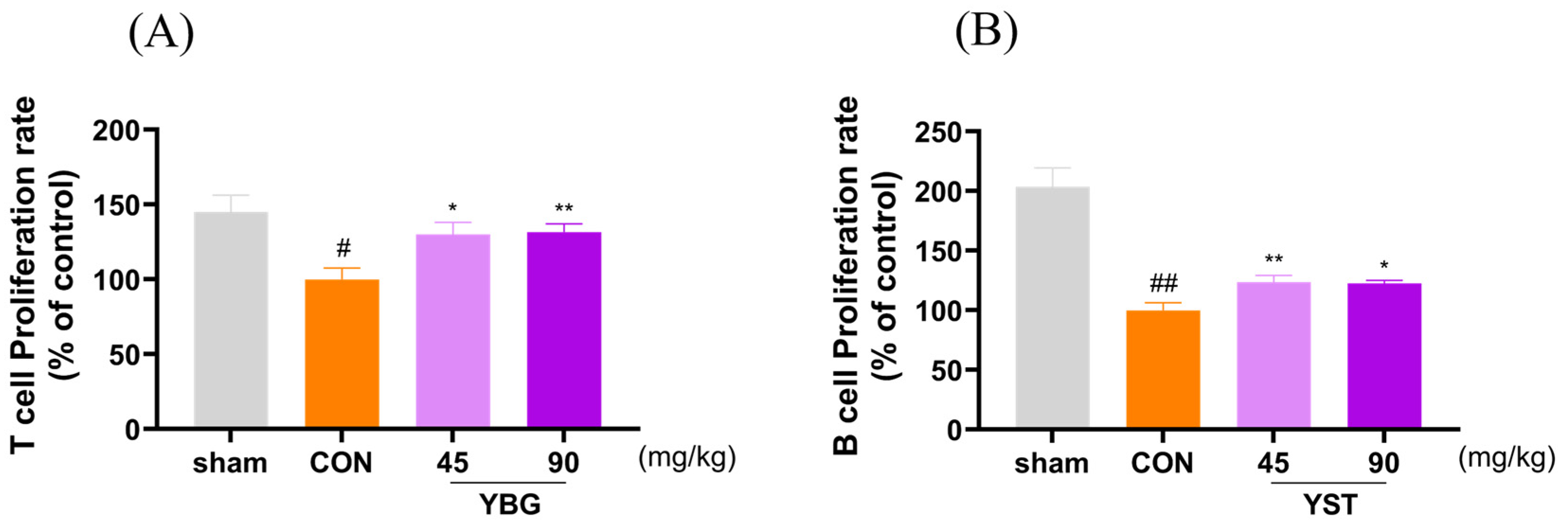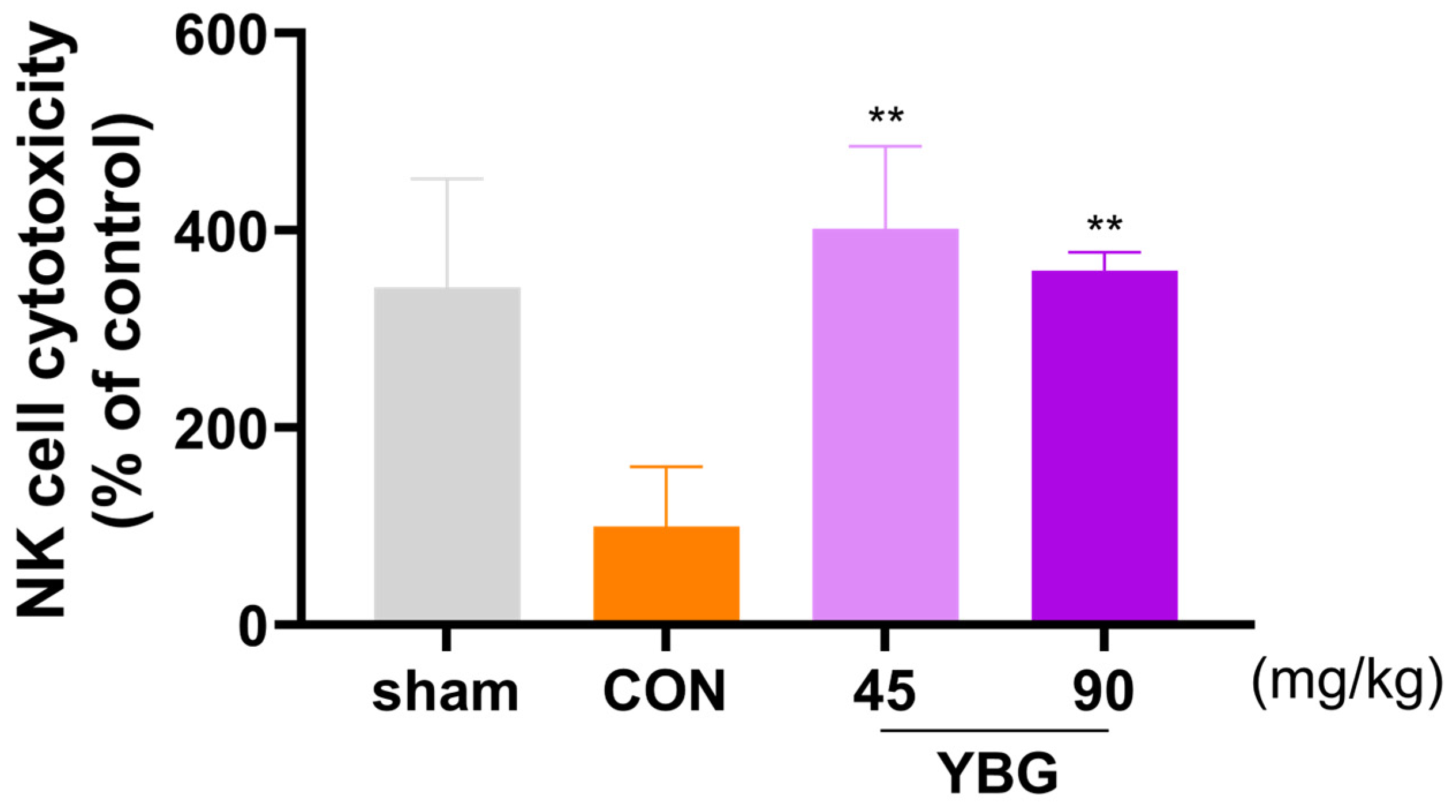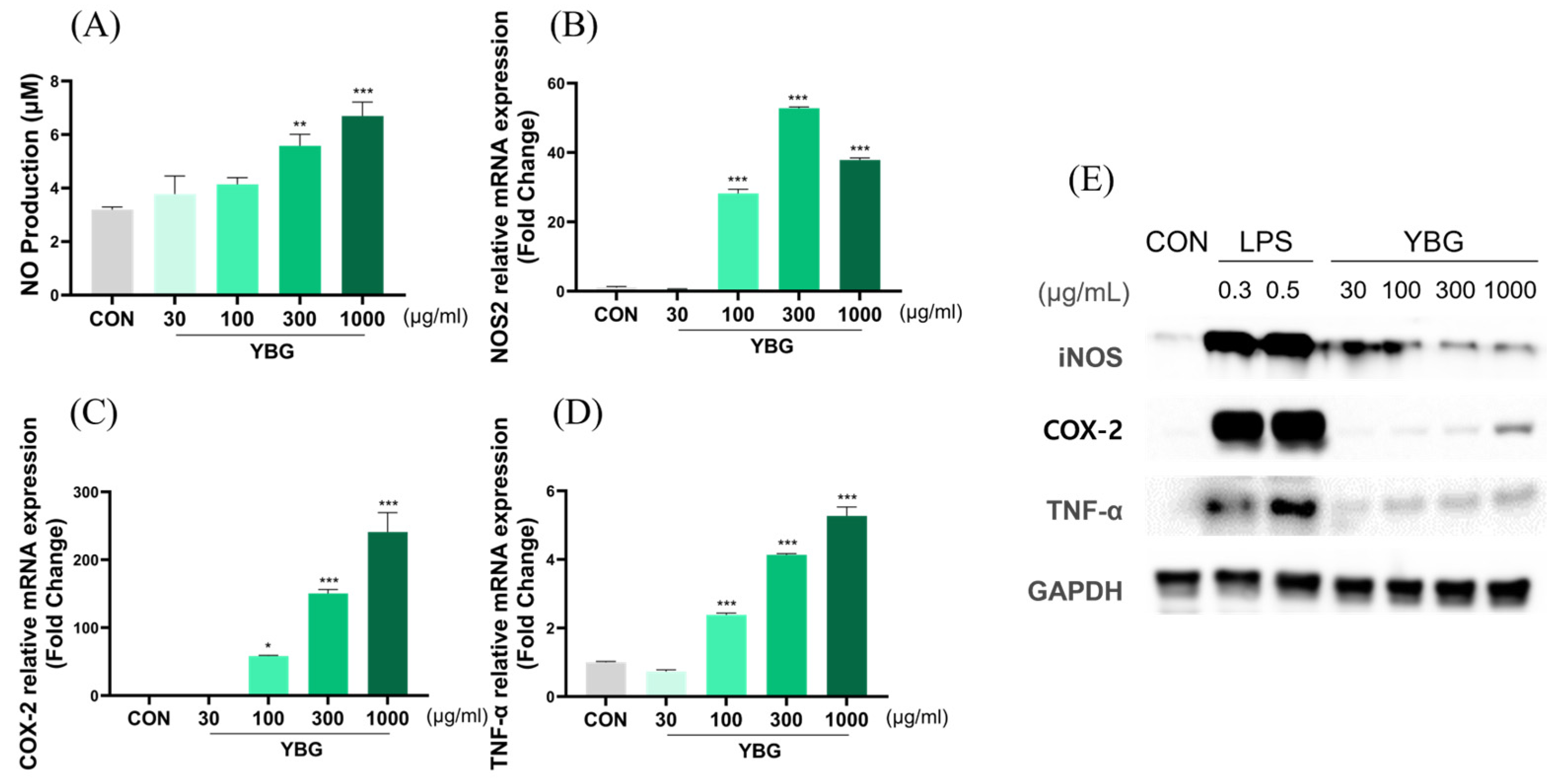Effects of Dietary Yeast β-1,3/1,6-D-Glucan on Immunomodulation in RAW 264.7 Cells and Methotrexate-Treated Rat Models
Abstract
:1. Introduction
2. Results
2.1. Effects of YBG on Body Weights and Organ Index of Immunosuppressed Rats
2.2. Effects of YBG on Hematological Parameters of Immunosuppressed Rats
2.3. Effects of YBG on Splenocyte Proliferation of Immunosuppressed Rats
2.4. Effects of YBG on NK Cell Activity of Immunosuppressed Rats
2.5. Effects of YBG on Cytokine Productions of Immunosuppressed Rats
2.6. Effects of YBG on Serum Immunoglobulin Levels of Immunosuppressed Rats
2.7. Effects of YBG on Cell Viability and Phagocytosis of RAW 264.7
2.8. Effects of YBG on Nitric Oxide and Cytokine Productions in RAW 264.7
3. Discussion
4. Materials and Methods
4.1. Preparation of β-Glucan
4.2. Animal and Experimental Designs
4.3. Measurement of Organ Index
4.4. Hematological Analysis
4.5. Spleen Lymphocyte Proliferation Analysis
4.6. Natural Killer Cell Activity Measurement
4.7. Serum Cytokine and Immunoglobulin Analysis
4.8. q-RT PCR Analysis
4.9. Cell Culture and Cell Viability Assay
4.10. Phagocytosis Assay
4.11. NO Production Assay
4.12. Statistical Analysis
5. Conclusions
Supplementary Materials
Author Contributions
Funding
Institutional Review Board Statement
Informed Consent Statement
Data Availability Statement
Acknowledgments
Conflicts of Interest
References
- Fernandes, F.A.; Carocho, M.; Prieto, M.A.; Barros, L.; Ferreira, I.C.F.R.; Heleno, S.A. Nutraceuticals and Dietary Supplements: Balancing out the Pros and Cons. Food Funct. 2024, 15, 6289–6303. [Google Scholar] [CrossRef] [PubMed]
- Chopra, A.S.; Lordan, R.; Horbańczuk, O.K.; Atanasov, A.G.; Chopra, I.; Horbańczuk, J.O.; Jóźwik, A.; Huang, L.; Pirgozliev, V.; Banach, M.; et al. The Current Use and Evolving Landscape of Nutraceuticals. Pharmacol. Res. 2022, 175, 106001. [Google Scholar] [CrossRef] [PubMed]
- Tieu, S.; Charchoglyan, A.; Wagter-Lesperance, L.; Karimi, K.; Bridle, B.W.; Karrow, N.A.; Mallard, B.A. Immunoceuticals: Harnessing Their Immunomodulatory Potential to Promote Health and Wellness. Nutrients 2022, 14, 4075. [Google Scholar] [CrossRef] [PubMed]
- Zhong, Z.; Vong, C.T.; Chen, F.; Tan, H.; Zhang, C.; Wang, N.; Cui, L.; Wang, Y.; Feng, Y. Immunomodulatory Potential of Natural Products from Herbal Medicines as Immune Checkpoints Inhibitors: Helping to Fight against Cancer via Multiple Targets. Med. Res. Rev. 2022, 42, 1246–1279. [Google Scholar] [CrossRef] [PubMed]
- Zaman, R.; Ravichandran, V.; Tan, C.K. Role of Dietary Supplements in the Continuous Battle against COVID-19. Phytother. Res. 2024, 38, 1071–1088. [Google Scholar] [CrossRef] [PubMed]
- Zhang, Y.; Zhang, Z. The History and Advances in Cancer Immunotherapy: Understanding the Characteristics of Tumor-Infiltrating Immune Cells and Their Therapeutic Implications. Cell. Mol. Immunol. 2020, 17, 807–821. [Google Scholar] [CrossRef]
- Couchoud, C.; Fagnoni, P.; Aubin, F.; Westeel, V.; Maurina, T.; Thiery-Vuillemin, A.; Gerard, C.; Kroemer, M.; Borg, C.; Limat, S.; et al. Economic Evaluations of Cancer Immunotherapy: A Systematic Review and Quality Evaluation. Cancer Immunol. Immunother. 2020, 69, 1947–1958. [Google Scholar] [CrossRef]
- Ali, S.A.; Singh, G.; Datusalia, A.K. Potential Therapeutic Applications of Phytoconstituents as Immunomodulators: Pre-Clinical and Clinical Evidences. Phytother. Res. 2021, 35, 3702–3731. [Google Scholar] [CrossRef]
- Rong, X.; Shen, C.; Shu, Q. Interplay between Traditional Chinese Medicine Polysaccharides and Gut Microbiota: The Elusive “Polysaccharides-Bond-Bacteria-Enzyme” Equation. Phytother. Res. 2024, 38, 4695–4715. [Google Scholar] [CrossRef]
- Li, C.-X.; Liu, Y.; Zhang, Y.-Z.; Li, J.-C.; Lai, J. Astragalus Polysaccharide: A Review of Its Immunomodulatory Effect. Arch. Pharm. Res. 2022, 45, 367–389. [Google Scholar] [CrossRef]
- Zhong, X.; Wang, G.; Li, F.; Fang, S.; Zhou, S.; Ishiwata, A.; Tonevitsky, A.G.; Shkurnikov, M.; Cai, H.; Ding, F. Immunomodulatory Effect and Biological Significance of β-Glucans. Pharmaceutics 2023, 15, 1615. [Google Scholar] [CrossRef] [PubMed]
- Mizuno, M.; Minato, K.-I. Anti-Inflammatory and Immunomodulatory Properties of Polysaccharides in Mushrooms. Curr. Opin. Biotechnol. 2024, 86, 103076. [Google Scholar] [CrossRef] [PubMed]
- De Marco Castro, E.; Calder, P.C.; Roche, H.M. β-1,3/1,6-Glucans and Immunity: State of the Art and Future Directions. Mol. Nutr. Food Res. 2021, 65, e1901071. [Google Scholar] [CrossRef] [PubMed]
- Stier, H.; Ebbeskotte, V.; Gruenwald, J. Immune-Modulatory Effects of Dietary Yeast Beta-1,3/1,6-D-Glucan. Nutr. J. 2014, 13, 38. [Google Scholar] [CrossRef] [PubMed]
- Fang, X.-H.; Zou, M.-Y.; Chen, F.-Q.; Ni, H.; Nie, S.-P.; Yin, J.-Y. An Overview on Interactions between Natural Product-Derived β-Glucan and Small-Molecule Compounds. Carbohydr. Polym. 2021, 261, 117850. [Google Scholar] [CrossRef] [PubMed]
- van Steenwijk, H.P.; Bast, A.; de Boer, A. Immunomodulating Effects of Fungal Beta-Glucans: From Traditional Use to Medicine. Nutrients 2021, 13, 1333. [Google Scholar] [CrossRef]
- Wani, S.M.; Gani, A.; Mir, S.A.; Masoodi, F.A.; Khanday, F.A. β-Glucan: A Dual Regulator of Apoptosis and Cell Proliferation. Int. J. Biol. Macromol. 2021, 182, 1229–1237. [Google Scholar] [CrossRef]
- Wang, N.; Liu, H.; Liu, G.; Li, M.; He, X.; Yin, C.; Tu, Q.; Shen, X.; Bai, W.; Wang, Q.; et al. Yeast β-D-Glucan Exerts Antitumour Activity in Liver Cancer through Impairing Autophagy and Lysosomal Function, Promoting Reactive Oxygen Species Production and Apoptosis. Redox Biol. 2020, 32, 101495. [Google Scholar] [CrossRef]
- Chen, S.-N.; Nan, F.-H.; Liu, M.-W.; Yang, M.-F.; Chang, Y.-C.; Chen, S. Evaluation of Immune Modulation by β-1,3; 1,6 D-Glucan Derived from Ganoderma lucidum in Healthy Adult Volunteers, A Randomized Controlled Trial. Foods 2023, 12, 659. [Google Scholar] [CrossRef]
- Adams, E.L.; Rice, P.J.; Graves, B.; Ensley, H.E.; Yu, H.; Brown, G.D.; Gordon, S.; Monteiro, M.A.; Papp-Szabo, E.; Lowman, D.W.; et al. Differential High-Affinity Interaction of Dectin-1 with Natural or Synthetic Glucans Is Dependent upon Primary Structure and Is Influenced by Polymer Chain Length and Side-Chain Branching. J. Pharmacol. Exp. Ther. 2008, 325, 115–123. [Google Scholar] [CrossRef]
- Han, B.; Baruah, K.; Cox, E.; Vanrompay, D.; Bossier, P. Structure-Functional Activity Relationship of β-Glucans From the Perspective of Immunomodulation: A Mini-Review. Front. Immunol. 2020, 11, 658. [Google Scholar] [CrossRef] [PubMed]
- Cronstein, B.N.; Aune, T.M. Methotrexate and Its Mechanisms of Action in Inflammatory Arthritis. Nat. Rev. Rheumatol. 2020, 16, 145–154. [Google Scholar] [CrossRef] [PubMed]
- Janaszak-Jasiecka, A.; Płoska, A.; Wierońska, J.M.; Dobrucki, L.W.; Kalinowski, L. Endothelial Dysfunction Due to eNOS Uncoupling: Molecular Mechanisms as Potential Therapeutic Targets. Cell. Mol. Biol. Lett. 2023, 28, 21. [Google Scholar] [CrossRef] [PubMed]
- Wang, W.; Zhou, H.; Liu, L. Side Effects of Methotrexate Therapy for Rheumatoid Arthritis: A Systematic Review. Eur. J. Med. Chem. 2018, 158, 502–516. [Google Scholar] [CrossRef] [PubMed]
- Ibrahim, A.; Ahmed, M.; Conway, R.; Carey, J.J. Risk of Infection with Methotrexate Therapy in Inflammatory Diseases: A Systematic Review and Meta-Analysis. J. Clin. Med. 2018, 8, 15. [Google Scholar] [CrossRef]
- Tidblad, L.; Westerlind, H.; Delcoigne, B.; Askling, J.; Saevarsdottir, S. Comorbidities and Chance of Remission in Patients with Early Rheumatoid Arthritis Receiving Methotrexate as First-Line Therapy: A Swedish Observational Nationwide Study. RMD Open 2023, 9, e003714. [Google Scholar] [CrossRef]
- Tuano, K.S.; Seth, N.; Chinen, J. Secondary Immunodeficiencies. Ann. Allergy. Asthma. Immunol. 2021, 127, 617–626. [Google Scholar] [CrossRef]
- Onda, K.; Honma, T.; Masuyama, K. Methotrexate-Related Adverse Events and Impact of Concomitant Treatment with Folic Acid and Tumor Necrosis Factor-Alpha Inhibitors: An Assessment Using the FDA Adverse Event Reporting System. Front. Pharmacol. 2023, 14, 1030832. [Google Scholar] [CrossRef]
- Ding, J.; Ning, Y.; Bai, Y.; Xu, X.; Sun, X.; Qi, C. β-Glucan Induces Autophagy in Dendritic Cells and Influences T-Cell Differentiation. Med. Microbiol. Immunol. 2019, 208, 39–48. [Google Scholar] [CrossRef]
- Ali, M.F.; Dasari, H.; Van Keulen, V.P.; Carmona, E.M. Canonical Stimulation of the NLRP3 Inflammasome by Fungal Antigens Links Innate and Adaptive B-Lymphocyte Responses by Modulating IL-1β and IgM Production. Front. Immunol. 2017, 8, 1504. [Google Scholar] [CrossRef]
- Zhu, Z.; He, L.; Bai, Y.; Xia, L.; Sun, X.; Qi, C. Yeast β-Glucan Modulates Macrophages and Improves Antitumor NK-Cell Responses in Cancer. Clin. Exp. Immunol. 2023, 214, 50–60. [Google Scholar] [CrossRef] [PubMed]
- He, L.; Bai, Y.; Xia, L.; Pan, J.; Sun, X.; Zhu, Z.; Ding, J.; Qi, C.; Tang, C. Oral Administration of a Whole Glucan Particle (WGP)-Based Therapeutic Cancer Vaccine Targeting Macrophages Inhibits Tumor Growth. Cancer Immunol. Immunother. 2022, 71, 2007–2028. [Google Scholar] [CrossRef]
- He, Y.; Du, J.; Dong, Z. Myeloid Deletion of Phosphoinositide-Dependent Kinase-1 Enhances NK Cell-Mediated Antitumor Immunity by Mediating Macrophage Polarization. Oncoimmunology 2020, 9, 1774281. [Google Scholar] [CrossRef] [PubMed]
- Eisinger, S.; Sarhan, D.; Boura, V.F.; Ibarlucea-Benitez, I.; Tyystjärvi, S.; Oliynyk, G.; Arsenian-Henriksson, M.; Lane, D.; Wikström, S.L.; Kiessling, R.; et al. Targeting a Scavenger Receptor on Tumor-Associated Macrophages Activates Tumor Cell Killing by Natural Killer Cells. Proc. Natl. Acad. Sci. USA 2020, 117, 32005–32016. [Google Scholar] [CrossRef] [PubMed]
- Khatua, S.; Simal-Gandara, J.; Acharya, K. Understanding Immune-Modulatory Efficacy in Vitro. Chem. Biol. Interact. 2022, 352, 109776. [Google Scholar] [CrossRef]
- Megha, K.B.; Joseph, X.; Akhil, V.; Mohanan, P.V. Cascade of Immune Mechanism and Consequences of Inflammatory Disorders. Phytomedicine 2021, 91, 153712. [Google Scholar] [CrossRef]
- Noh, H.-J.; Park, J.M.; Kwon, Y.J.; Kim, K.; Park, S.Y.; Kim, I.; Lim, J.H.; Kim, B.K.; Kim, B.-Y. Immunostimulatory Effect of Heat-Killed Probiotics on RAW264.7 Macrophages. J. Microbiol. Biotechnol. 2022, 32, 638–644. [Google Scholar] [CrossRef]
- Liu, Y.; Yang, J.; Guo, Z.; Li, Q.; Zhang, L.; Zhao, L.; Zhou, X. Immunomodulatory Effect of Cordyceps Militaris Polysaccharide on RAW 264.7 Macrophages by Regulating MAPK Signaling Pathways. Molecules 2024, 29, 3408. [Google Scholar] [CrossRef]
- du Sert, N.P.; Hurst, V.; Ahluwalia, A.; Alam, S.; Avey, M.T.; Baker, M.; Browne, W.J.; Clark, A.; Cuthill, I.C.; Dirnagl, U.; et al. The ARRIVE Guidelines 2.0: Updated Guidelines for Reporting Animal Research. PLoS Biol. 2020, 18, e3000410. [Google Scholar] [CrossRef]
- Nair, A.; Jacob, S. A Simple Practice Guide for Dose Conversion between Animals and Human. J. Basic Clin. Pharm. 2016, 7, 27. [Google Scholar] [CrossRef]








| Gene | Primer | Seqeunce |
|---|---|---|
| GAPDH | F | CTTGTGACAAAGTGGACATTGTT |
| R | TGACCAGCTTCCCATTCTC | |
| IL-2 | F | CTCCCCATGATGCTCACGTT |
| R | TCCAGCGTCTTCCAAGTGAA | |
| IL-6 | F | TCCGCAAGAGACTTCCAGC |
| R | GCCGAGTAGACCTCATAGTGACC |
| Gene | Primer | Seqeunce |
|---|---|---|
| GAPDH | F | CTTGTGACAAAGTGGACATTGTT |
| R | TGACCAGCTTCCCATTCTC | |
| TNF-α | F | GAGAAGTTCCCAAATGGCCT |
| R | AGCCACTCCAGCTGCTCCT | |
| COX-2 | F | ATCCATGTCAAAACCGTGGG |
| R | TTGGGGTGGGCTTCAGCAG | |
| NOS2 | F | ACCAAGATGGCCTGGAGGAA |
| R | CCGACCTGATGTTGCCATTG |
Disclaimer/Publisher’s Note: The statements, opinions and data contained in all publications are solely those of the individual author(s) and contributor(s) and not of MDPI and/or the editor(s). MDPI and/or the editor(s) disclaim responsibility for any injury to people or property resulting from any ideas, methods, instructions or products referred to in the content. |
© 2024 by the authors. Licensee MDPI, Basel, Switzerland. This article is an open access article distributed under the terms and conditions of the Creative Commons Attribution (CC BY) license (https://creativecommons.org/licenses/by/4.0/).
Share and Cite
Son, J.; Hwang, Y.; Hong, E.-M.; Schulenberg, M.; Chai, H.; Jo, H.-G.; Lee, D. Effects of Dietary Yeast β-1,3/1,6-D-Glucan on Immunomodulation in RAW 264.7 Cells and Methotrexate-Treated Rat Models. Int. J. Mol. Sci. 2024, 25, 11020. https://doi.org/10.3390/ijms252011020
Son J, Hwang Y, Hong E-M, Schulenberg M, Chai H, Jo H-G, Lee D. Effects of Dietary Yeast β-1,3/1,6-D-Glucan on Immunomodulation in RAW 264.7 Cells and Methotrexate-Treated Rat Models. International Journal of Molecular Sciences. 2024; 25(20):11020. https://doi.org/10.3390/ijms252011020
Chicago/Turabian StyleSon, Joohee, Yeseul Hwang, Eun-Mi Hong, Marion Schulenberg, Hyungyung Chai, Hee-Geun Jo, and Donghun Lee. 2024. "Effects of Dietary Yeast β-1,3/1,6-D-Glucan on Immunomodulation in RAW 264.7 Cells and Methotrexate-Treated Rat Models" International Journal of Molecular Sciences 25, no. 20: 11020. https://doi.org/10.3390/ijms252011020
APA StyleSon, J., Hwang, Y., Hong, E.-M., Schulenberg, M., Chai, H., Jo, H.-G., & Lee, D. (2024). Effects of Dietary Yeast β-1,3/1,6-D-Glucan on Immunomodulation in RAW 264.7 Cells and Methotrexate-Treated Rat Models. International Journal of Molecular Sciences, 25(20), 11020. https://doi.org/10.3390/ijms252011020








